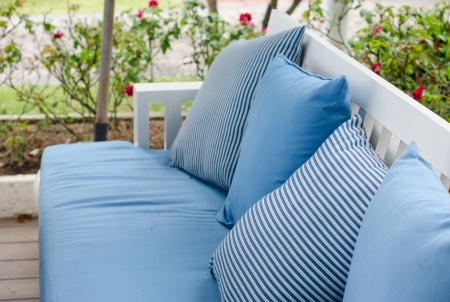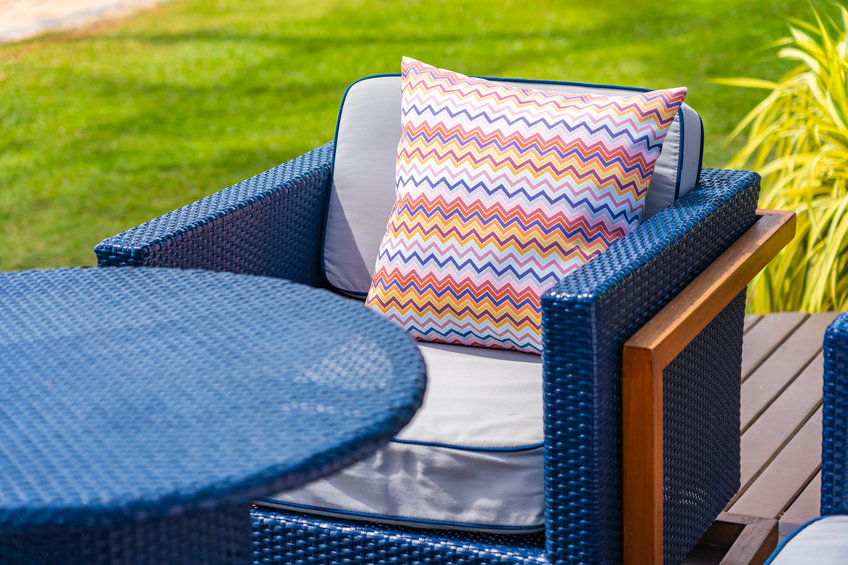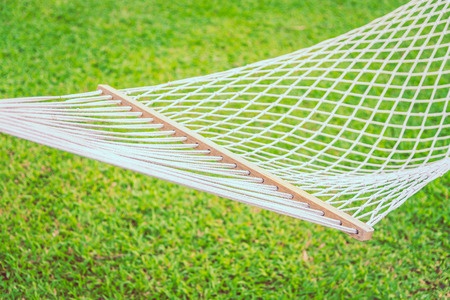- Clean Home
- Clean
- Cleaning Tips For Patio Furniture
Cleaning Tips for Patio Furniture
Cleaning tips for patio furniture. Have you ever tried to clean a glass patio tabletop? It's an exercise in futility. You wipe it, it dries, and streaks appear. Dirty streaks.
You wipe it again, it dries, and the dirty streaks multiply. The same challenges arise with other outdoor furniture - you're battling Mother Nature here, after all!
These cleaning tips for patio furniture can help clear things up.
Cleaning Tips for Patio Furniture Cushions
Most patio furniture cushions today have synthetic covers and polyester filling and are designed to withstand the elements.
Still, they could use some help if you'd like them to last for the long term (or at least a few seasons). These cleaning tips for patio furniture and polyester-coated cushions can help:
- Hose down outdoor cushions occasionally.
- Turn them often for even wear and sun exposure, just like you do your couch cushions.
- Avoid getting sunscreen on the cushions. Hose off spills or sunscreen smears immediately.
- To deep-clean cushions, spray enzyme cleaner on stubborn spots. Then, set the cushions on their ends in the sun until completely dry.
- If you detect mildew, put the cushions on a flat outdoor surface and saturate them with 1 cup of bleach, 3 gallons of warm water, and 1/4 cup of laundry detergent. Let the wet cushions sit in the sun for several hours. Rinse. If necessary, let them dry in the sun for several days.
- Clean away any remnants from the outdoor season before storing cushions for the winter because set stains are nearly impossible to remove. Store clean cushions in plastic bags (I use trash bags) for the winter.
Cleaning Tips for Patio Furniture by Material
Fortunately (or maybe wisely), outdoor furniture is constructed to take abuse - and soil. Generally speaking, if your furniture is near a pool or spa, hose it down once a week because chlorine will damage most furniture finishes.
These cleaning tips for patio furniture can help you safely clean furnishings by material type.
Cleaning Aluminum
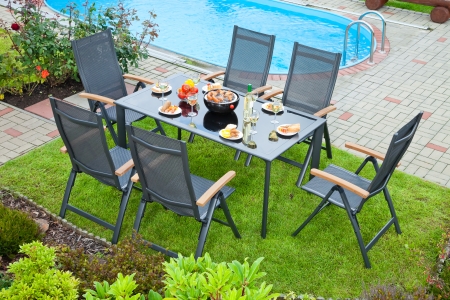
Clean aluminum patio furniture with mild liquid detergent, rinse, and dry. Coat with automotive wax every six months.
Warning: Sunscreens can stain aluminum and many other kinds of outdoor furniture. If you wear sunscreen, protect the chair you're sitting in with a towel.
Cleaning Tips for Patio Furniture of Plastic or Resin
Plastic furniture doesn't require much care. Wash it with a mild soapy solution, hose it off, and towel dry. Avoid products with ammonia, but use a diluted bleach solution for stains. Polish resin furniture with car wax if desired.
Cleaning Tips for Patio Furniture of Teak
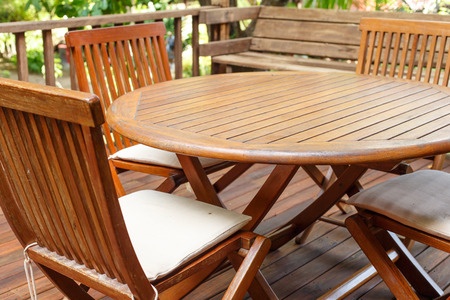
Teak is a popular choice for outdoor furniture because it weathers well. Do not use teak oil on outdoor furniture because it will act as a dust magnet—clean teak with a mild soap solution and a soft brush.
Rinse well. Keep teak furniture in the sun because dampness will cause mildew.
Cleaning Tips For Patio Furniture of Vinyl
Clean vinyl furniture with warm, soapy water. Never use bleach, as it can damage the finish, allowing the porous material to stain, fade, and weaken faster.
Cleaning Wicker (natural)
Wicker outdoor furniture should be cleaned once a year unless there are spills (ha!). For natural wicker, first tip the chair to one side and vacuum it well.
Then, wash it with a solution of mild detergent and water, using a toothbrush to get at those hard-to-reach spots.
Rinse with a garden hose. Towel the wicker dry, and let it sit for 24 hours before using.
Polish wicker furniture with furniture polish occasionally. Natural wicker will rot in the sun, so place it in a shady spot or beneath your umbrella. Never cover wicker with plastic because it will trap moisture and encourage mildew.
Cleaning Wicker (resin or vinyl)
Clean patio furniture made of synthetic wicker by washing it in soapy water, then rinse and dry each piece. You can polish it with a spray-on polish.
Cleaning Patio Furniture of Wood
Wood furniture should be cleaned at least once a year. It should be washed with a mild detergent and scrubbed with a brush. It should be stored indoors over winter.
Cleaning Wrought Iron
Wash wrought iron with soapy water; rinse and towel dry. Wax or polish it twice a year. Touch up any rust spots immediately. During the winter, either bring wrought iron indoors or cover.
Cleaning Hammocks
Cotton hammocks soak up water like a sponge.
When you first bring them out in the spring, spray them with a water repellant to minimize water retention.
To clean hammocks, lay them flat and scrub them with a solution of hand dishwashing detergent in warm water using a nylon scrubber. Rinse and clean the other side. Rinse again and hang to dry. Never use bleach on these natural relaxers - it will rot the fibers.
Cleaning Patio Tabletops
These are hard to clean flat. The trick to cleaning a patio table is to turn it on its side (very carefully when dealing with glass) and hose it down first to remove surface grime.
Then, wipe it off with a sponge dipped in soapy water. Hose again. Then wipe dry. If you can't turn it sideways, move the chairs back and hose from the traditional angle (but it might take a couple of tries!).
Cleaning Patio Umbrellas
To clean a patio umbrella, take it apart and put the top part back into the stand so that it's within reach. Then, crank the umbrella open and wash it with a liquid cleaner and a sponge.
Use the detergent made for convertible car tops if your umbrella is vinyl. It works wonders on these sun-beaten skin-savers.
Dry the umbrella open in full sun for a day or two. Never put an umbrella away, even slightly damp. That's a recipe for mildew.
- Clean Home
- Clean
- Cleaning Tips For Patio Furniture
